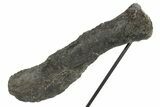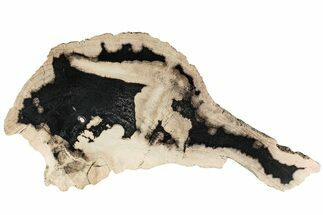This Specimen has been sold.
11.2" Sauropod Dinosaur (Camarasaurus) Chevron - Colorado
This is a 11.2" tall chevron of Camarasaurus from the Dinosaurs Of America Quarry near Dinosaur, Colorado. There is some crack fill restoration and the end of the chevron has been restored. It comes with a custom metal display stand.
Chevrons, or haemal arches, are bones attached to the underside of caudal (tail) vertebrae, forming the ventral surface of the tail. A chevron comprises a left and right part, which are typically fused to each other in a V-shaped fashion, enclosing a large opening that can be seen in front or back view. The openings of multiple consecutive chevrons form the haemal canal of the tail, which protects nerves and blood vessels.
Chevrons, or haemal arches, are bones attached to the underside of caudal (tail) vertebrae, forming the ventral surface of the tail. A chevron comprises a left and right part, which are typically fused to each other in a V-shaped fashion, enclosing a large opening that can be seen in front or back view. The openings of multiple consecutive chevrons form the haemal canal of the tail, which protects nerves and blood vessels.
About Camarasaurus
Camarasaurus was a medium-sized sauropod dinosaur whose fossils are found in the Morrison Formation of the Southest United States. It is estimated to have reached lengths of up to 75 feet long and had an estimated maximum weight of around 50 tons. Compared to contemporary Diplodocids, it had a shorter tail, longer forelimbs, and a much larger and more robust skull.
Camarasaurus skulls are quite distinctive: they have blunt snout and quite a square shape. Camarasaurus had large, spoon-shaped teeth, unlike many sauropod dinosaurs that had small, peg-like teeth. This likely indicates that it ate coarser vegetation, allowing it to share the same environment as other sauropods without competing for food. It may have replaced its teeth approximately every 60 days as they became worn from chewing. Its cervical vertebrae had hollow chambers to reduce weight on the neck, leading to its name, which means “chambered lizard”.
Camarasaurus is considered the most abundant of the sauropod dinosaurs found in North America. Its fossils have been found in almost every major Morrison Formation dinosaur locality, with fossils found in localities from across many states including New Mexico, Utah, Colorado, Montana and Oklahoma.
Camarasaurus was a medium-sized sauropod dinosaur whose fossils are found in the Morrison Formation of the Southest United States. It is estimated to have reached lengths of up to 75 feet long and had an estimated maximum weight of around 50 tons. Compared to contemporary Diplodocids, it had a shorter tail, longer forelimbs, and a much larger and more robust skull.
Camarasaurus skulls are quite distinctive: they have blunt snout and quite a square shape. Camarasaurus had large, spoon-shaped teeth, unlike many sauropod dinosaurs that had small, peg-like teeth. This likely indicates that it ate coarser vegetation, allowing it to share the same environment as other sauropods without competing for food. It may have replaced its teeth approximately every 60 days as they became worn from chewing. Its cervical vertebrae had hollow chambers to reduce weight on the neck, leading to its name, which means “chambered lizard”.
Camarasaurus is considered the most abundant of the sauropod dinosaurs found in North America. Its fossils have been found in almost every major Morrison Formation dinosaur locality, with fossils found in localities from across many states including New Mexico, Utah, Colorado, Montana and Oklahoma.
SPECIES
Camarasaurus grandis
LOCATION
Dinosaurs Of America Quarry, Dinosaur, Colorado
FORMATION
Morrison Formation
SIZE
11.2" tall, 14.4" tall on stand
CATEGORY
SUB CATEGORY
ITEM
#209203
We guarantee the authenticity of all of our specimens.
 Reviews
Reviews




















